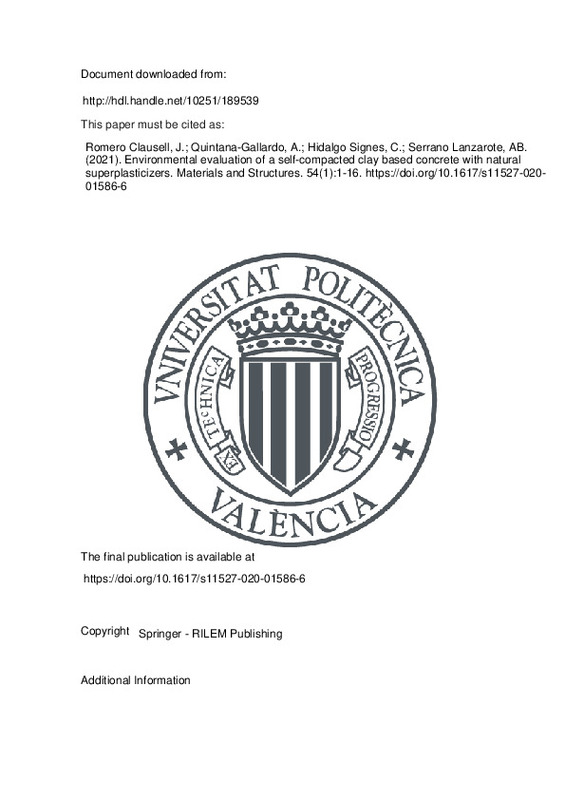Gagg CR (2014) Cement and concrete as an engineering material: An historic appraisal and case study analysis. Eng Fail Anal 40:114–140. https://doi.org/10.1016/j.engfailanal.2014.02.004
Andrew RM (2017) Global CO2 emissions from cement production. Earth SystSci Data Discuss. https://doi.org/10.5194/essd-2017-77
Climate Emergency Declaration - Call to declare a climate emergency, 2020
[+]
Gagg CR (2014) Cement and concrete as an engineering material: An historic appraisal and case study analysis. Eng Fail Anal 40:114–140. https://doi.org/10.1016/j.engfailanal.2014.02.004
Andrew RM (2017) Global CO2 emissions from cement production. Earth SystSci Data Discuss. https://doi.org/10.5194/essd-2017-77
Climate Emergency Declaration - Call to declare a climate emergency, 2020
Hamard E, Cazacliu B, Razakamanantsoa A, Morel JC (2016) Cob, a vernacular earth construction process in the context of modern sustainable building. Build Environ 106:103–119. https://doi.org/10.1016/j.buildenv.2016.06.009
Moevus M, Jorand Y, Olagnon C, Maximilien S, Anger R, Fontaine L, Arnaud L (2016) Earthen construction: an increase of the mechanical strength by optimizing the dispersion of the binder phase. Mat Struct 49(4):1555–1568
Ouellet-Plamondon CM, Habert G (2016) Self-Compacted Clay based Concrete (SCCC): Proof-of-concept. J Clean Prod 117:160–168. https://doi.org/10.1016/j.jclepro.2015.12.048
Ben-Alon L, Loftness V, Harries KA, DiPietro G, Hameen EC (2019) Cradle to site life cycle assessment (lca) of natural vs conventional building materials: a case study on cob earthen material. Build Environ. https://doi.org/10.1016/j.buildenv.2019.05.028
Garro Galvez JM, Riedl B, Conner AH (1997) Analytical studies on tara tannins. Holzforschung. https://doi.org/10.1515/hfsg.1997.51.3.235
Nataraja MC, Sanjay MC (2013) Modified Bolomey equation for the design of concrete. J CivEng 41(1):59–69
Clausell JR, Signes CH, Solà GB, Lanzarote BS (2020) Improvement in the rheological and mechanical properties of clay mortar after adding CeratoniaSiliqua L. extracts. Constr Build Mater 237:117747. https://doi.org/10.1016/j.conbuildmat.2019.117747
UNE-EN 12350-2 (2020) Testing fresh concrete - Part 2: Slump test. Spanish association for normalization and certification (AENOR), Madrid
ISO 14040: Environmental management–life cycle assessment—Principles and framework,” Int. Organ. Stand., 2006
American Concrete Institute, “ACI 360R-92: Guide to Design of Slabs-on-Ground.”
EHE-08 (2008) Instrucción de hormigón estructural, Com. Perm. del Hormigón, p. 702
Db-Se-ae CTE (2003) CodigoTécnico de la Edificación, DocumentoBásico: Acciones en la Edificación. Ministerio de Fomento, Madrid
Huntzinger DN, Eatmon TD (2009) A life-cycle assessment of Portland cement manufacturing: comparing the traditional process with alternative technologies. J Clean Prod 17(7):668–675
Pascual-González J, Guillén-Gosálbez G, Mateo-Sanz JM, Jiménez-Esteller L (2016) Statistical analysis of the ecoinvent database to uncover relationships between life cycle impact assessment metrics. J Clean Prod 112:359–368. https://doi.org/10.1016/j.jclepro.2015.05.129
Huntzinger DN, Eatmon TD (2009) A life-cycle assessment of Portland cement manufacturing: comparing the traditional process with alternative technologies. J Clean Prod. https://doi.org/10.1016/j.jclepro.2008.04.007
Ali MB, Saidur R, Hossain MS (2011) A review on emission analysis in cement industries. Renew Sustain Energy Rev. https://doi.org/10.1016/j.rser.2011.02.014
Portland Cemment Association (2019) How Cement is Made, Portland Cement Association.
United States Environmental Protection Agency, (2003) Air Emissions Factors and Quantification. Sand And Gravel Processing, p. 300
T Stengel and P Schießl, (2013) Life cycle assessment (LCA) of ultra high performance concrete (UHPC) structures, in Eco-Efficient Construction and Building Materials: Life Cycle Assessment (LCA), Eco-Labelling and Case Studies. In: Pacheco-Torgal F, Cabeza LF, Labrincha J, de Magalhães A
(eds), Woodhead Publishing, 2014, pp. 528-564
Hon DN-S (2001) “Cellulose: Chemistry and Technology”, in Encyclopedia of Materials: Science and Technology. Elsevier, Second Edi., pp 1039–1045
United States Environmental Protection Agency, (2003) Air Emissions Factors and Quantification. Clay Processing. pp. 1–4
“Life Cycle Assessment of Sodium Hydroxide,” Aust. J. Basic Appl. Sci., 2013.
Castell JC, Sorolla S, Jorba M, Aribau J, Bacardit A, Ollé L (2013) Tara (CaesalpiniaSpinosa): The sustainable source of tannins for innovative tanning processes. J Am Leather ChemAssoc 108:221–230
Steubing B, Wernet G, Reinhard J, Bauer C, Moreno-Ruiz E (2016) The ecoinvent database version 3 (part II): analyzing LCA results and comparison to version 2. Int J Life Cycle Assess. https://doi.org/10.1007/s11367-016-1109-6
European Platform on Life Cycle Assessment, Environmental Footprint.
Huntzinger DN, Eatmon TD (2009) A life-cycle assessment of Portland cement manufacturing: comparing the traditional process with alternative technologies. J Clean Prod 17(7):668–675. https://doi.org/10.1016/j.jclepro.2008.04.007
Çankaya S, Pekey B (2019) A comparative life cycle assessment for sustainable cement production in Turkey. J Environ Manage. https://doi.org/10.1016/j.jenvman.2019.109362
[-]







![[Cerrado]](/themes/UPV/images/candado.png)


